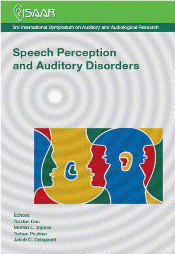Recognition rates and linguistic processing: Do we need new measures of speech perception?
Abstract
Speech perception goes far beyond the recognition of phonemes, words, and sentences. The Oldenburg Linguistically and Audiologically Controlled Sentences (OLACS) were developed for investigating the interactions between the listener’s linguistic and auditory capabilities in speech perception. Using these sentences with normal-hearing and hearingimpaired listeners in different listening conditions, a small but significant influence of the sentences linguistic complexity was detected. To some degree this influence was related to other cognitive measures of the listeners. In an eye-tracking experiment delayed eye movements for more complex sentences indicated a higher cognitive load during the speech recognition process. These delayed eye movements were sensitive even in conditions where classical recognition rate and speech reception measures were not sensitive because the recognition rate was near 100%.References
Efron, B. and Tibshirani, R. J. (1993). An introduction to the bootstrap. New York, NY: Chapman and Hall.
Gibson, E. (1998). “Linguistic complexity: locality of syntactic dependencies” Cognition, 68, 1-76.
Kim, S. Kim, M. and Chun, M. M. (2005). “Concurrent working memory load can reduce distraction.” in Proceedings of the National Academy of Sciences of the United States of America (PNAS), 102, 16524-16529.
Knoeferle, P., Habets, B., Crocker, M. W., and Müntje, T. F. (2008). “Visual Scenes Trigger Immediate Syntactic Reanalysis: Evidence from ERPs during Situated Spoken Comprehension” Cerebral Cortex, 18, 789-795.
Kollmeier, B. and Wesselkamp, M. (1997) “Development and evaluation of a German sentence test for objective and subjective speech intelligibility assessment” J. Acoust. Soc. Am. 102, 2412-2421.
Schriefers, H., Friederici, A. D., and Kühn, K. (1995). “The processing of locally ambiguous relative clauses in German” Journal of Memory and Language, 34, 499-520.
Tanenhaus, M. K., Spivey-Knowiton, M. J., Eberharda, K. M., and Sedivy, J. C. (1995). „Integration of Visual and Linguistic Information in Spoken Language Comprehension” Science 268, 1632–1634.
Tewes, U. (1991). Hamburg-Wechsler-Intelligenztest für Erwachsene - Revision 1991 (HAWIE-R). Bern, Stuttgart, Toronto: Huber.
Uslar, V. N., Ruigendijk, E., Hamann, C., Brand, T., and Kollmeier, B. (2011). “How does linguistic complexity influence intelligibility in a German audiometric sentence intelligibility test?” Int. J. Audiol., 50, 621-631.
Uslar, V. N., Carroll, R., Hanke, M., Hamann, C., Ruigendijk, E., Kollmeier, B., and Brand, T. (in preparation). “On the interdependence of linguistic complexity, listening condition and cognitive abilities in speech intelligibility measurements: findings for listeners with normal hearing using new sentence material”
Uslar, V. N, Kollmeier, B., Brand“, T. (in preparation). “On the interdependence of linguistic complexity, listening condition and cognitive abilities in speech intelligibility measurements: findings for older listeners with and without hearing loss”
Wendt, D., Kollmeier, B., and Brand, T. (in preparation). “How does linguistic complexity influence eye movements during the recognition of sentences in an audio-visual task ?”
Wendt, D., Kollmeier, B., and Brand, T. (in preparation). “The influence of linguistic complexity and noise on speech comprehension: Evidence from eye movements”
Downloads
Published
How to Cite
Issue
Section
License
Authors who publish with this journal agree to the following terms:
a. Authors retain copyright* and grant the journal right of first publication with the work simultaneously licensed under a Creative Commons Attribution License that allows others to share the work with an acknowledgement of the work's authorship and initial publication in this journal.
b. Authors are able to enter into separate, additional contractual arrangements for the non-exclusive distribution of the journal's published version of the work (e.g., post it to an institutional repository or publish it in a book), with an acknowledgement of its initial publication in this journal.
c. Authors are permitted and encouraged to post their work online (e.g., in institutional repositories or on their website) prior to and during the submission process, as it can lead to productive exchanges, as well as earlier and greater citation of published work (See The Effect of Open Access).
*From the 2017 issue onward. The Danavox Jubilee Foundation owns the copyright of all articles published in the 1969-2015 issues. However, authors are still allowed to share the work with an acknowledgement of the work's authorship and initial publication in this journal.


